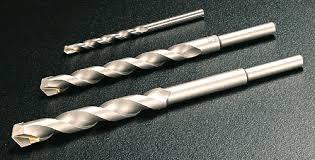

The baseline function of these tools-unlike most others-is to cause vibration, so keeping the tip on a pencil dot requires a slow, methodical start until the bit hollows out the beginning of the hole. With a store-bought bracket or hose hanger, line up the holes with the mortar joint. To position something where you need it, say a shelf bracket, drill a pilot hole first and use a pencil or awl or to mark the concrete where the hole should line up.When fastening to brick or block, it is advisable to set the fastener or shield in the mortar joint between blocks.They’re more expensive and last longer than hammer drill bits. This Slotted Drive System employs a thick bit end and grooves in which the bit travels. With their smooth shank, these can only be used with a hammer drill and its 3-jaw chuck.įor a rotary hammer, the bit is called SDS Plus. Generally speaking, hammer drill bits look like typical twist drill bits with an arrowhead of carbide at the tip and tighter fluting. (That said, it may sometimes be hard to tell the difference between bits.) Perhaps the better answer to this question is that the “best” bit is the one you need to get the job done. While there’s a lot of parity among bits for general use, there are a lot of factors that go in to defining “best,” many of them subjective and situational. The heavier the tool is the more it can do because the size of the components that do it get more massive as the tool capacity increases.įor 99% of around-the-house drilling, a tool in the 5-pound range with a ¾-inch bit holder will do just about anything you’ll need to do, from demo to drilling. While it may seem silly, the main industry classification for rotary hammers tends to be by weight and chuck (or “bit holder”) size-5-pound, 10-pound, etc. There are some smaller cordless tools that are affordable and operate on a battery platform you may already have. Of course, it’s more expensive (though not much for a corded model), as are the bits.

It’s also smoother to operate, drills faster, drills larger holes, and is orders of magnitude quieter.

And once you use one, you’ll probably want to leave your hammer drill in the rearview mirror.Ī rotary hammer works like a jackhammer that twists: The bit reciprocates (i.e., travels forward and back in a linear fashion). Rotary HammerĪ rotary hammer is what a hammer drill wants to be when it grows up. This creates enough vibration (and noise they’re loud and whiny tools) for the steel bit to pulverize the hard material in front of it and for the flutes to evacuate most of it.Ī hammer drill is primarily for occasional drilling and smaller holes-think plastic anchors and screws (say for shutters or running coaxial cable) or #10 concrete screws. Think about a gubbins like two poker chips rubbing together at high speed. The actual part that does the vibrating is called a gubbins. The way a hammer drill works is to combine vibration with the twisting action of a typical drill. Even if you don’t need it right now, chances are you will. If you’re going to purchase a cordless drill/driver, it’s advisable to get the hammer drill function. You’ve probably noticed that you can buy a cordless drill/driver or drill/driver kit where the included drill has a hammer drill function. Hammer Drill or Rotary Hammer? Hammer drill They both do essentially the same thing but are vastly different tools. The best drill for concrete today is one of two tools: A hammer drill or a rotary hammer. While the process remains unchanged-pulverize the concrete, remove the dust from the hole-the tools most certainly have changed.

Others were more along the lines of what we’d call a “cold chisel.” Some bit tips had a star pattern similar to what we’d call an SDS bit today. Hit the bit like a nail, twist the bit a quarter turn, repeat. (There were dedicated hand-saw sharpeners too, but that’s another story).Īnd in our age of microchipped tools, we’re lucky we don’t remember this because the last things pre-power tool concrete drilling was were fast or easy.īack in the day, the best drill for concrete (and the only one) was a hardened steel bit, a sledgehammer, and a hand strength Thor would admire. And it wasn’t that long ago that any larger masonry job had a blacksmith on hand heating and re-sharpening chisels. Some of us might remember the pre-power tool days of drilling holes in masonry and concrete.


 0 kommentar(er)
0 kommentar(er)
